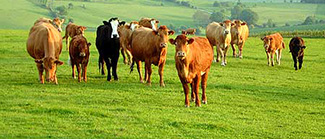







Let us start with Milwaukee. Here, it is fairly safe to say that hides generally run to the spready side. However, there are exceptions, these being based, for the most part, on the particular demands made of packers for certain types of meat. While the demands on some packers are such that their kill makes very spready hides, another who kills for one of the better chain stores produces some of the best small packer hides anywhere- plump cows, heifers, and steers. Nevertheless, the bulk of the hides in Milwaukee are spready. Now, keep in mind, if the price of boning cattle becomes very high, packers, even in Milwaukee, may perhaps go all the way down into Missouri to buy cheaper cattle until the price of spready dairy cattle returns to normal.
This may help tanners to understand why, even in the same section of the country, there are variations in the types of hides produced. As we move farther north, along the northern border of Wisconsin, hides are plumper than in the southern part of the state. In St. Paul, Minneapolis and Duluth, Minnesota, they are considerably plumper. Crossing over from Minnesota into Iowa, North and South Dakota, hides from these states are about as considerably plump as you are apt to find. The Omaha-Sioux City area is one of the larger hide producing regions, just as is the case with Kansas City, East St. Louis and perhaps other sections in the Midwest.
Coming back East, through Illinois, one feels the influence of being close to Wisconsin. But, from Illinois through Indiana, hides run medium to plump unless the packer is killing for boning or sausage operations. Hides from Indiana and Ohio are noted for their good grain. Some have raised the question as to why hides from these two states have such good grains. The answer boils down to the way the cattle are fed. Domestic cattle from these states are often brought into the barns while they are young, kept there and fed there. Later, some find their way into feedlots. However, much of the cattle in these two states are not exposed to briar scratches, such as on the western ranges, and they maintain good grain.
Many of the hides produced in Michigan have a tendency to be spready, but not all. Michigan has some beef cattle and occasional feedlots. Just as is the case in many other states, Michigan is importing cattle, with a number of beef cattle finding their way to market in that state. Some states import cattle from as many as a dozen other states. The feedlot brought this about.
Changes in methods of transportation whereby a small packer can ship by refrigerated trucks, and no longer needs to own refrigerated cars, has also changed not only the type of cattle he kills but has allowed him to expand his operations considerably. There again, each individual packer kills according to his trade. One packer may produce plump hides with an average of 60 pounds and another next door with an average of 50.
(Source: Hides & Skins. National Hide Association. Pages 152-153)